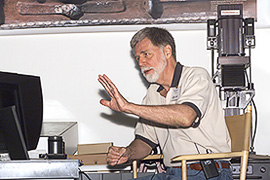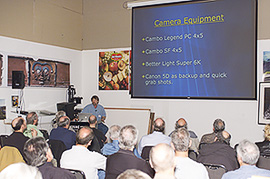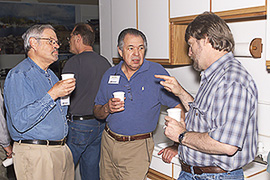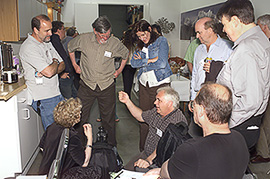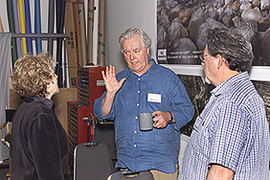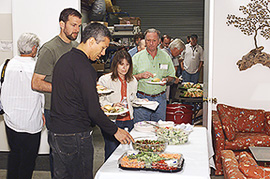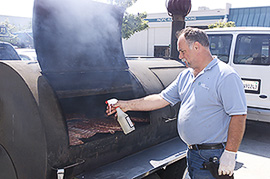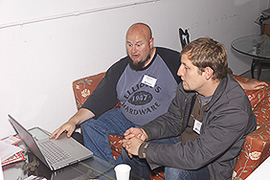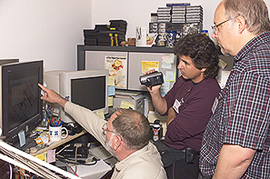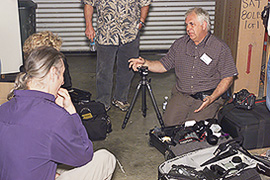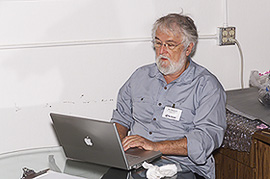
|
BETTER LIGHT'S 6th "Almost Annual" OWNERS CONFERENCE
May 31 – June 1, 2007 Location: Better Light Offices & Studio, San Carlos, California |
|||||||||||||||||||||||||||||||||||
|
It's Not Easy...But, It's Worth It! Working with a scanning back takes more effort than other digital cameras, but the results are well worth it… and clients in all markets are beginning to recognize and appreciate the difference. This year’s meeting was a celebration by those who believe in a statement used by Mike Collette that was a paraphrase of Ansel Adams, “Use the highest-performance camera you can carry”. Truly, the Better Light scanning back is a unique piece of equipment with the ability to produce images of incredible resolution and detail that are appreciated by all who attended. Once again a group of 70+ scanning back believers (owners) and staff gathered in Better Light’s San Carlos, CA demo studio for two days to share their love of large format digital capture and the passion to achieve perfection. The annual Better Light Owners’ Conference continues to be the best bargain in the photo industry with a registration fee of just $150 per person to pay for expenses and meals, including our now-famous Thursday night barbecue. Our theme for this year was “The Better Light Scanning Back in Action”. In past years, we often had more technical presentations, somewhat driven by equipment and software improvements. As our family of owners grows we have seen some great work being created, and we wanted to provide an opportunity to share some of these success stories about large format digital photography. The 2007 Conference was arguably the best program in our 6-year Conference history, with new tips and techniques shared in all aspects of Better Light applications – including art reproduction, architecture, commercial, fine art, and landscape photography. Our speakers shared their images and the stories behind-the-scenes to reveal travel and location tips, ways of overcoming lighting obstacles, and special gizmos and gadgets they use to help get their jobs done. The common thread was their love of the scanning back and how much it has helped to build and maintain their business success by delivering images to their clients that competitors cannot match. Each year we get requests for cassette tapes or videos of the programming, but this event is a “happening”, something you really have to experience for yourself. Beyond the logistics of recording the sessions, the results would be about as effective as watching a video of a roller coaster ride instead of being there yourself… screaming at the top of your lungs from the front seat. So, the following summary of the programs will attempt to give you a taste of the conference, plus a number of the presentations have been prepared for download – just click here for an index of topics. After our initial introductions on Thursday morning, Mike Collette, Better Light’s president and inventor of our favorite piece of photography equipment, got the program started with a discussion about landscape photography with a scanning back, providing his insight into the tools and techniques recommended to achieve the highest image quality. “Exceptional images can be the result of your labors with large format (using film or digital) when these basic steps are executed properly”, Mike outlined, “1) Camera setup and focus must be perfect. 2) Exposure should be optimized, avoiding overexposure of the brightest highlights. 3) Tone expression should be determined at capture time, since it will often affect exposure. 4) Post-capture processing is essential for bringing out the best in each image”. Mike proceeded to offer tips for optimizing focus and exposure, and how exposure settings affect dynamic range. He discussed how to deal with image “Tone Expression” and how to use ViewFinder’s Tone Curve and ToneZones™ to control your results and use as much of the dynamic range as possible. The exposure should be set to place the highlights where desired – not too high, and select (or modify) the Tone Curve to keep the shadows open. Especially when in the field, the objective is getting the image to “fit” the available range, and make subtle adjustments later. “Post-capture processing is an important part of your photography, just as careful print-making in the darkroom was an essential step ‘in the good ol’ days’”, Mike added. Digital images from the scanning back should be sharpened, and may need artifact removal, color cast removal, and final tone adjustments, or any subjective alterations that you might care to make. Maintaining your image data as 16-bits per color allows considerable post-capture adjustment without visible degradation. All of Better Light’s USB models initially save all images as “raw” files and allow you to retrieve them as either 16-bits or 8-bits per color, and even change the tone curve processing. A variety of Mike’s post-production tips are included in his presentation slides, available as a PDF download. SHELLEY LAKE, Sky Lake Studio, Easthampton, MA Next up to the podium was Shelley Lake, who has a background in science and art that provides her with a unique vision to produce photographic artwork of still life and nature, plus provide high-quality photographic and print-making services to other artists in her area. Shelley was one of our first “featured photographers” and has been producing beautiful landscape images since she went digital with the Better Light scanning back. She proclaimed that if she had it all to do over again, she would like to avoid her three biggest mistakes: 1) Placing copy lights at a 45° angle, 2) Leaving the set screw in place when mounting her Schneider lens on the lens board, and 3) Living too close to the edge. Her story about “living on the edge” resulted in an unexpected tumble of her camera, tripod and pano adapter over the cliff at Horseshoe Bend in Page, Arizona… and even though Better Light products are extremely rugged and reliable, the pano adapter didn’t survive that fall. RON FINLEY, Ron Finley Studios, West Lake Village, CA Ron Finley’s diverse applications for his Better Light Super6K include portraits, product photography, architecture, cars, landscapes, poster art, composite imaging and art reproduction. He had so much to share, we gave him two time slots in this year’s program. Ron certainly understands the value of high-resolution imaging and proudly says “I’ve got the megapixels, so I want to use them in any possible opportunity”— and he does just that. Beyond his ability to make “mind-blowing prints of incredible accuracy”, Ron believes that working with large files has other benefits including: reducing error and increasing accuracy in image editing; easier scaling of different elements in composite assembly; creating finished work that can be re-used at a larger scale without starting over; and inspiring clients to think about big images… promoting new revenue opportunities for his studio. In his Thursday presentation, Ron discussed his commercial work that includes quite a bit of composite imaging, using green screen backgrounds and Zmatte™ software to create clean-edged subjects for assembly. It was evident that careful planning, skillful lighting, patience in directing the subject, and meticulous post-production were all as important as the large, high-definition files produced by the Better Light. If you visit the website of Ron Finley Studio, it’s fairly obvious that Ron loves dogs. He has recently completed a graphic novel “Shaggy Dogs Story” that demonstrates his great sense of humor, creativity and photographic talent. It’s a must see at http://www.shaggydogsstory.com . On Friday, we asked Ron back to share some of his work and techniques in art scanning through his alter-ego Penguin Digital Arts. A summary of Finley’s presentation of art reproduction is available for download as a PDF file. This includes image tests that demonstrate a reduction in surface reflections when a longer lens is used, and his techniques and setup for “tiling” when shooting larger artworks in sections. Ron has made a rolling easel wall and camera tripod dolly that he uses for much of this work. He also built an 8 ft x 12 ft rolling wall for very large paintings, and he even takes it on location! Plans for “Uncle Ron’s pipe dolly” are available at www.ronfinleystudio.com. JESSE BRAVO, Bravo Images, Fair Oaks, CA Jesse Bravo has quite a story of his journey from photojournalist to museum photographer. His first “exposure” to Better Light was during a seminar on digital photography by Stephen Johnson. It was the classic story of being in the right place at the right time – when the Crocker Art Museum in Sacramento CA advertised for a photographer “using a Better Light scanning back”, Jesse jumped at the opportunity. Through his work at the Crocker he has photographed many large and delicate paintings. A firm believer in the Zig-Align for camera to art parallelism, Jesse had been limited by the inability to put an alignment mirror in direct contact with the original art. With an idea from one of the archivists at the Crocker and some sheet metal fabrication by Dave Christensen of North Light Products, Jesse created the first “Dian-align”. This apparatus acts as a surrogate for the artwork and is placed in between the art and the camera. Using a precision laser measuring device, the rectangular metal box is aligned to the art surface with a three-measurement “triangulation”. A large mirror on the back of the metal box is then used as the target surface for a Zig-align device in the camera. Another tool that Jesse now uses on a regular basis is Equalight™, a light balancing software program by Robin Myers of Better Light. Jesse showed a number of embossed paper artworks he photographed that required severe side-light in order to demonstrate the dimensional relief of the surface. Obviously, the lighting from side-to-side on the art was very uneven. By photographing a clean white surface under the exact same conditions, the Equalight software could determine the amount of light falloff in the scene and apply the appropriate correction to each pixel of the photograph of the art itself. Jesse showed a wide variety of paintings, drawings, ceramics, sculptures and photographs that he has digitized over the past few years for the Crocker Museum and local artists… each offering their unique challenges. In addition to his contract duties with the Crocker Museum, Jesse maintains a commercial photography business with a mixture of architecture, panoramics, automobiles, and food. JACK NEITH, JDN Photography Inc., Shamong, NJ Each year there seems to be more interest in making high-resolution images of architectural subjects, and as photographers begin to “think digitally”, working with the scanning back in most any situation becomes possible. Jack Neith has been a successful commercial and architectural photographer for over 25 years with his images appearing on consumer and trade magazine covers, in advertising campaigns and product brochures. He made the transition to digital capture several years ago to maintain a competitive edge in the rapidly changing market. The ability to continue using a 4x5 view camera, with unrestricted use of lens focal lengths and camera movements, is a major advantage. Nobody uses a scanning back, or a large-format view camera, because they are easy – it’s because the results are often worth the extra effort involved. At a previous Better Light Conference Jack had picked up a tip that Mike Richardson used with his clients, and since then Jack unrolls a large print of one of the images from a job when he delivers the job to the client… ”I love watching their initial reaction when they see the extraordinary detail in the big print”, Jack added. When asked if he faced more problems in shooting architecture with the scanning back than film, he said, “I’d say they were different challenges rather than more problems. In a lot of ways, digital has been easier”. When shooting with film, Jack would spend hours prepping the scene… filtering fluorescent lamps, putting light balancing gels and neutral density over the windows, and adding supplemental lighting. “Now I have changed the way I think about each shot”, Jack said. “I know I can do multiple exposures for color balance or exposure problems and blend them in Photoshop later.” With the time saved in dealing with variations in lighting, Jack has more time to concentrate on the fine details of the photo and has seen his work improve with digital capture. One drawback that he has noted with the Better Light system is that the client really doesn’t like to see you “sitting around” while waiting for a scan to finish – “time is money”! To solve this problem, Jack now carries a DSLR and takes other views and close-ups while waiting for the scan. The client is even happier because they now get dozens of photos instead of just a few high-resolution hero shots. BRAD FLOWERS, Dallas Museum of Art, Dallas, TX What better way to wrap up the first day and get ready for our BBQ dinner than have one of our Texas “good ol’ boys” share his scanning stories. Brad Flowers is staff photographer for the Dallas Museum of Art, one of the first museums to use a Better Light scanning back for digitizing their collections. He also operates a freelance business in Gun Barrel City, TX to give an interesting point-of-view between the structure of the museum environment and working on his own with local artists and businesses. The Dallas Museum of Art has one of the largest collections of silver in the country, so Brad has become quite an expert in photographing anything and everything silver – dinnerware, flatware, platters, pitchers, etc. He showed how he controls the highly reflective surfaces while maintaining a smooth gradation of tone and the metallic character of his subjects. Like most museum photographers, Brad’s subjects range from small to large with every type of surface from varnished oil paintings to tapestries. He uses the scanning back for nearly all of his work, and lights his subjects with several HMI units in softboxes. Over the years, Brad has found shortcuts and techniques that save him time and produce consistent results. Brad showed images of the many projects he has photographed and shared some of his “trade secrets” in lighting, backgrounds, and color management. A sampling of the presentation is available for download. JIM COLLUM, Jim Collum Photography, Santa Cruz, CA Jim Collum has a unique ability to capture the beauty of light and texture while facing all types of environmental and photographic challenges. His work has a beautiful simplicity as still-life studies of the shapes and textures of landscape, architectural and industrial subjects. Part of Jim’s photographic style is his skill in print-making. He described his method for making hand-coated platinum prints and his experiments with the platinum process over color pigment prints. The results are truly unique with the dominant visual appearance of a fine art monochrome print, but with subtle hints of color. The process is explained on his website at www.jcollum.com.
JIM MORRIS, Morris Editions, Silver Springs, MD This is the third time that Jim Morris has been on the program… and each time he stimulates the crowd with his innovative techniques and unbridled creativity. Although Jim does a great deal of architectural and jewelry photography for his “day job”, it is obvious that he loves to work in nature for landscapes and abstracts as outlets for his creative energy. His presentation this year showed some of the unique fine art images that he was able to create from a relatively simple image using multiple layers with rotation and scaling variations, combined with selective colorizing or tone manipulation. STEPHEN JOHNSON, Stephen Johnson Photography, Pacifica, CA Steve Johnson has been involved from the very beginning of the digital scanning back, having shared the experience of making the first high resolution scans with Mike Collette when “prototype #1” was fully operational. Steve recalled his first experiences with digital capture and noted it as “the day that film died” for him. As he strolled back and forth across the room, describing the thoughts and experiences he has enjoyed in his career, the projection screen was filled with an extensive collection of his unique photography of the world around us. He told of the time that he was sitting in the back of the room at an early Photoshop World conference when the inspiration came to him to create “With a New Eye”, a ground-breaking digital photography project of the National Parks, which has consumed much of his time and attention over the past decade. Steve is a very unique talent… a photographer, designer, author and teacher, who has conquered the technology of digital photography and yet maintained the sincerity of a true artist. MIKE RICHARDSON, Richardson Photography in Torrance, CA Our final speaker is fondly referred to as “The Rev”, since Mike Richardson has long been an active evangelist of the Better Light scanning back. As a very successful commercial photographer, Mike continually challenges the scanning back in all types of product photography, location, architecture and panoramic assignments. He shared an array of images he has made over the years with examples of how the addition of a Better Light scanning back literally changed his life and financial success. Several large projects that he has done since adding the scanning back have saved his clients considerable time and money over the alternative of film… and still made Mike enough extra profit to pay for his scanning back and several upgrades over the years. You’ll just have to be there to find out! Next year…get your reservations in early and join us for a great experience.
2009 Conference – "A Politive Influence in a Tough Economy" 2008 Conference – "Conference Returns to the East Coast" 2006 Conference – The Hottest Ever 2006 Post-Conference Field Trip 2005 Conference Emphasizes Varied Applications 2002 Conference Followed Photo Expo East
Copyright 2007-09 Better Light, Inc. All Rights Reserved.
|
|
||||||||||||||||||||||||||||||||||
